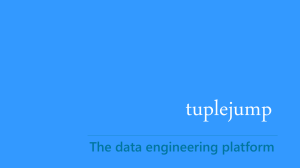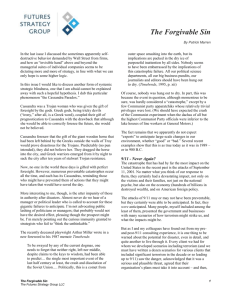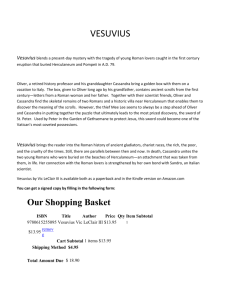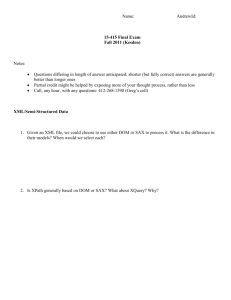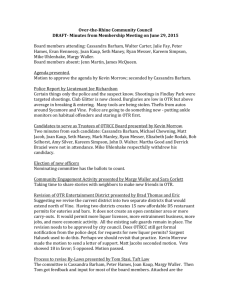CASSANDRA Newsletter No. 1
advertisement
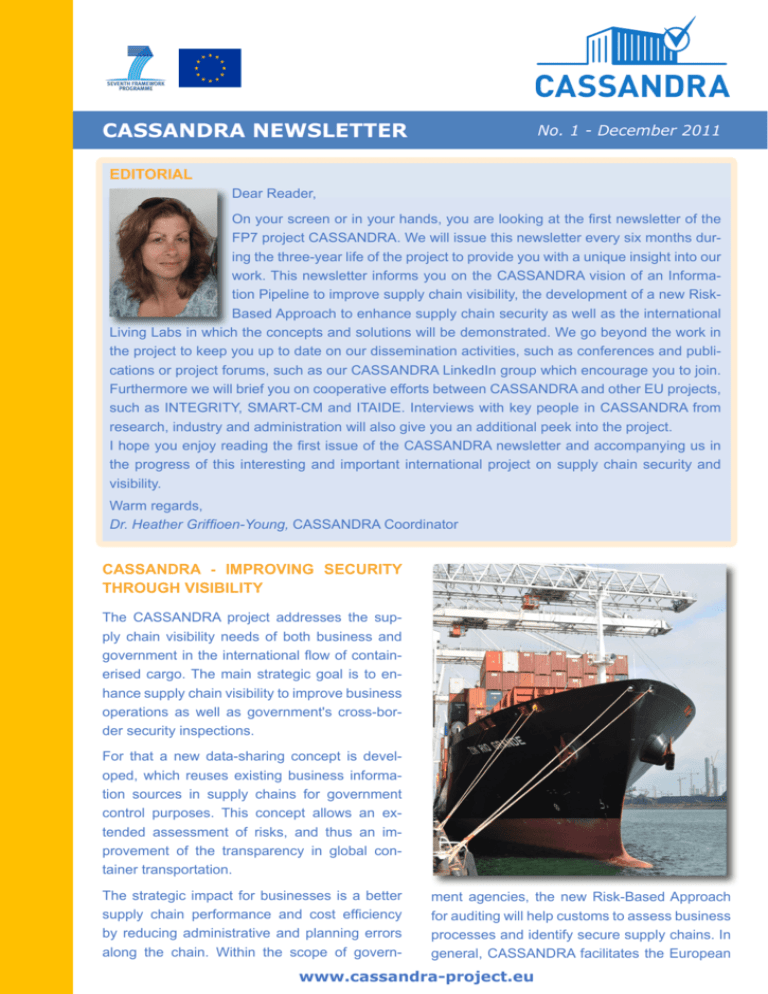
CASSANDRA NEWSLETTER No. 1 - December 2011 Editorial Dear Reader, On your screen or in your hands, you are looking at the first newsletter of the FP7 project CASSANDRA. We will issue this newsletter every six months during the three-year life of the project to provide you with a unique insight into our work. This newsletter informs you on the CASSANDRA vision of an Information Pipeline to improve supply chain visibility, the development of a new RiskBased Approach to enhance supply chain security as well as the international Living Labs in which the concepts and solutions will be demonstrated. We go beyond the work in the project to keep you up to date on our dissemination activities, such as conferences and publications or project forums, such as our CASSANDRA LinkedIn group which encourage you to join. Furthermore we will brief you on cooperative efforts between CASSANDRA and other EU projects, such as INTEGRITY, SMART-CM and ITAIDE. Interviews with key people in CASSANDRA from research, industry and administration will also give you an additional peek into the project. I hope you enjoy reading the first issue of the CASSANDRA newsletter and accompanying us in the progress of this interesting and important international project on supply chain security and visibility. Warm regards, Dr. Heather Griffioen-Young, CASSANDRA Coordinator CASSANDRA - Improving Security through visibility The CASSANDRA project addresses the supply chain visibility needs of both business and government in the international flow of containerised cargo. The main strategic goal is to enhance supply chain visibility to improve business operations as well as government's cross-border security inspections. For that a new data-sharing concept is developed, which reuses existing business information sources in supply chains for government control purposes. This concept allows an extended assessment of risks, and thus an improvement of the transparency in global container transportation. The strategic impact for businesses is a better supply chain performance and cost efficiency by reducing administrative and planning errors along the chain. Within the scope of govern- ment agencies, the new Risk-Based Approach for auditing will help customs to assess business processes and identify secure supply chains. In general, CASSANDRA facilitates the European www.cassandra-project.eu and global trade by improving security and the effectiveness of businesses and government operations. Risk-Based Approach and PiggyBacking Currently, each cross-border trade transaction is inspected individually, based on declaration data submitted to government authorities. CASSANDRA shifts the attention from transaction data quality to overall process quality. In terms of supply chain management this means, that with a Risk-Based Approach (RBA) secure and known container flows are identified. This System-Based Auditing allows government authorities to use accessible data of businesses for their own risk assessment of the cargo processes. This re-use is called the Piggy-Backing Principle, giving more opportunity to investigate riskier container flows. Information Pipeline The core innovation of CASSANDRA is the development of an Information Pipeline for sharing information across the supply chain and the government inspection agencies. CASSANDRA will achieve interoperability of heterogeneous systems by combining state of the art IT innovations. The pipeline consists of interoperable solutions, communicating in an open, flexible and standardized manner. Living Labs The Living Lab research approach studies the project‘s innovations in complex real world settings. There will be three global Living Labs: AsiaEurope, Europe-USA and Europe-Africa. Each Lab holds one or more trade lanes. Rotterdam, Bremerhaven, Felixstowe, Barcelona and Setúbal container ports will be involved. The freight forwarding companies DHL, Kuehne+Nagel, Seacon and BAP will provide the Living Labs with actual container flows. From INTEGRITY, ITAIDE AND SMARTCM to CASSANDRA Interview with Dr. Nils Meyer-Larsen, INTEGRITY project manager from the Institute of Shipping Economics and Logistics in Bremen, Germany. Nils, what are the results of the INTEGRITY project? INTEGRITY’s main goal was to improve the reliability and predictability of doorto-door container chains significantly by optimizing the supply chain visibility. Kernel of the project was the development of the so-called Shared Intermodal Container Information System (SICIS) allowing authorised companies and authorities to access planning and status information of container transports. Matching logistics data with security information, e.g. from CSDs (Container Security Devices), together with the integration of the AEO (Authorised Economic Operator) approach allow to satisfy both the logistics industry and custom authorities fulfilling their duties thus creating win-win situations. The success of SICIS was impressively demonstrated by the fact that more than 5400 containers were tracked on their way from China to Europe during INTEGRITY’s demonstration phase. No other research project has handled such a large number of containers, underlining the potential of this innovative system. Furthermore, INTEGRITY was the first project to follow the vision of the Information Pipeline, which is now one of the central points in CASSANDRA. Concerning the objectives, what are the differences between INTEGRITY and CASSANDRA? As described above, INTEGRITY was focusing on the improvement of the visibility of container supply chains by designing appropriate concepts and developing the SICIS system. www.cassandra-project.eu CASSANDRA will further elaborate this data-sharing approach, extending it to additional geographical areas and introducing a new approach towards risk assessment. Consequently, CASSANDRA will further integrate different worldwide approaches concerning supply chain visibility. What are your expectations of the CASSANDRA project? First of all, I think that the successful work and the results achieved within the INTEGRITY project form a good basis for CASSANDRA and I expect that the efforts, especially in the Asia-Europe corridor, will continue and be extended to the other CASSANDRA Living Labs. The approach towards enhanced visibility in the international flow of containerised cargo, taking into account the requirements of both business and government, will lead to a further improvement of container security and logistics processes in worldwide container logistics. Interview with Prof. Dr. Yao-Hua Tan, ITAIDE project coordinator from the Delft University of Technology, The Netherlands. Yao-Hua, what are the results of the ITAIDE project? The key topic of the ITAIDE project was the trade facilitation and control dilemma faced by government and how it could be addressed by means of innovative solutions (both IT and redesigned procedures). The project applied a Living Lab approach where different industry partners, operating in different sectors and countries, formed the focal organizations. ITAIDE ran the Beer Living Lab, Paper Living Lab, Food Living Lab and Drug Living Lab. Key themes in the multi-disciplinary research, next to IT design and development, were standardization, interoperability, procedural redesign (control), value assessment and network collaboration and adoption. Partner companies that collaborated in these Living Labs were, to mention a few, IBM, SAP, Heineken, Arla, FrieslandCampina and the world largest pharmaceutical company. Key results of the ITAIDE project that I consider very relevant for CASSANDRA are on the one hand a proof-of-concept for the ideas of “piggy-backing” and “data pull”. Companies have already invested heavily in IT. The government agencies in international trade, like customs and phyto-sanitary, can re-use the data for their own purposes, instead of obliging businesses to invest in multiple interfaces with the government. In the ITAIDE Living Labs, we also took this Piggy-Backing Principle one step further, demonstrating the possibilities of a Data Pull model. Instead of pushing regulatory documents from business to government, the data are pulled from the companies’ systems. These two principles underpin the Information Pipeline that we investigate in the CASSANDRA project. CASSANDRA will also make use of so-called Living Labs and benefits of the extensive experience in the ITAIDE project. The Living Labs provide a real-life, real-time setting in which public and private actors participate and can reach innovative win-win solutions. Furthermore, Living Labs can play an important role in consensus-building, networking and collective action for the actual adoption of the solutions. www.cassandra-project.eu Concerning the objectives, what are the differences between ITAIDE and CASSANDRA? ITAIDE focused more generally on the fact that governments on the one hand have to control trade to limit the risks of fraud and terrorism, and on the other hand want to facilitate trade, ensuring that traders do not have high administrative burdens. The general objectives regarding Single Window, Authorized Economic Operators and pan-European interoperability were taken as point-of-departure. Within each of the Living Labs, this was addressed differently, also because of the different focal organizations, so there were multiple innovative demonstrators developed and piloted. Where the ITAIDE project investigated System-Based Auditing, the focus in CASSANDRA - and this is a key difference - is on further development of an advanced RiskBased Approach. The focus is not only on high-risk targeting and profiling, but also on smart use of data, using business intelligence and data mining technology. This is an advanced Risk-Based Approach that is also in line with the European Commission and the World Customs Organization. A key point is that for the Risk-Based Approach, CASSANDRA proposes to piggyback on commercial data from business, like invoices and international contracts of sale, as well as data on the flow of the goods, and to exchange these data through the so-called Information Pipeline. What are your expectations of the CASSANDRA project? We will take the lessons learned from ITAIDE and the other projects (INTEGRITY and SMARTCM), which give us a solid basis to further developing the Information Pipeline and Risk-Based Approach. I expect that these two will be piloted at a large scale in CASSANDRA’s Living Labs. The Living Labs are real pilots, with the active participation of both businesses and customs organizations, jointly collaborating in the innovation processes. The three Living Labs concern trade lanes between Europe and Asia, Europe and USA as well as Europe and Africa. With large scale I also mean that we will follow a considerable number of real containers and real shipments, as there will be multiple trade lanes under investigation in each Living Labs, which form the basis of the pilot and its evaluations. We will actively pursue to disseminate these results to all customs organizations and companies in Europe. www.cassandra-project.eu Living Labs Europe-USA and AsiaEurope kicked off One of the most comprehensive innovations of CASSANDRA is the Living Lab idea, where the three global trade lanes Asia-Europe, EuropeUSA and Europe-Africa are examined. A Living Lab research describes a novel approach that shifts the development of a new product from the laboratory into the real world. Within the scope of the transport corridors Asia-Europe and Europe-USA, these Living Labs have recently started its work and both make good progress. In the following the setup stage is described using the example of the Living Lab Europe-USA. The next newsletter issue will discuss the stage of actual piloting in detail, taking the example of Living Lab Asia-Europe. integrated and demonstrated into the Living Lab, that means a new data-sharing concept or a new software solution is developed and practiced. Here special attention is paid to the interests and needs of all stakeholders as well as to the local environment. This includes the requirements and risk parameters of German and American authorities concerning container security as well as the restrictions of companies with regard to data sharing and data security. All In terms of the Living Lab Europe-USA, mem- these factors must be considered for the inte- bers of the CASSANDRA project defined their gration of various systems based on a service- plans on a workshop in Bremerhaven. Later on, oriented architecture. In the end, the results of this plan has been introduced to external stake- the Living Lab Bremerhaven and the trade lane holders in order to discuss the next steps. It has Europe-USA will be compared and synthesized with the results of the Living Labs for the transport corridors Asia-Europe and Africa-Europe. The Bremen Senator of Ports Martin Günthner said that it is a great success for the seaports of Bremen with the important connection Bremerhaven-USA to participate on the Living Lab within the CASSANDRA project. “For the competitiveness of the ports of Bremen, especially with been agreed that at first, the Institute of Shipping Economics and Logistics (ISL) and the Bremen Senator for Economics, Labour and Ports will analyze the data traffic for the trade lane from Europe to the United States using the container terminal Bremerhaven, the most important European export hub for the transport of goods to the USA. regard to the export business to the USA, the security of container transportation plays an important role since 9-11. Thus, the participation of Bremen’s ports on the European security project CASSANDRA is an important step for the further optimization of container handling in Bremen and Germany.” Join our Group: This also requires a close cooperation with the container terminal operators and other parties involved in port operations. Once the systems and interfaces have been studied, they will be linkedin.com/groups/FP7-CASSANDRA-4038704 www.cassandra-project.eu Meet CASSANDRA Since summer 2011, our project has been presented on several global events on transport and logistics. For example, the members of the CASSANDRA consortium introduced the project’s contents and its concept, talked about the aim of improving security in intermodal transportation or discussed the assessement of risks in the field of containerized cargo. Find a range of our international CASSANDRA performances as an important part of our dissemination activities below. EVENT NAME TOOK PLACE IN e-Freight Conference 2011 Munich, Germany 23 NOFOMA Conference on Logistics and Supply Chain Management in a High North Perspective Harstad, Norway European Conference on Shipping & Ports - ECONSHIP 2011 Chios, Greece Cargo Security Supply Chain Industry Day Arlington, USA 1st Workshop on IT Innovations Enabling Seamless and Secure Supply Chains - WITNESS 2011 Delft, The Netherlands 10th International Electronic Government Conference - EGOV 2011 Delft, The Netherlands 6 Future Security Research Conference Berlin, Germany International Conference on Logistics - HICL 2011 Hamburg, Germany 6th Partnership in Customs Academic Research and Development Conference - PICARD 2011 Geneva, Switzerland GS1 Industry & Standards Autumn Event 2011 Cologne, Germany 4 European Conference on ICT for Transport and Logistics - ECITL 2011 Thessaloniki, Greece IAME Conference 2011 Latin America Santiago de Chile 3 International NCAS Conference Future of Aviation Security Frankfurt, Germany rd th th rd Late November CASSANDRA has been presented within the Intermodal Europe 2011 in Hamburg. Beneath the slogan “Containers in motion - container transport and logistics across road, rail and sea” CASSANDRA shared a common booth with the project INTEGRITY. A lot of visitors from container industry as well as terminal operators and port representatives have shown their interest concerning the aim to improve container security and visibilty. We would like to thank all those interested for discussing and supporting CASSANDRA’s work and would be pleased to welcome you back as a stakeholder of the project in future. 4 TH EUROPEAN CONFERENCE ON 4 TRANSPORT LOGISTICS www.cassandra-project.eu ICT Common Assessment and Analysis of Risk in Global Supply Chains Project Partners Project Coordination Dr. Heather Griffioen-Young TNO - Netherlands Organisation for Applied Scientific Research Phone: +31 30 256 4608 Mail: heather.griffioen@tno.nl Project Communication Mr. Leif Peters ISL - Institute of Shipping Economics and Logistics Phone: +49 421 220 96 34 Mail: peters@isl.org www.cassandra-project.eu All pictures by ISL, TNO and TU Delft Contact Information
